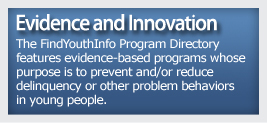Benefits for Youth, Families, and Communities
Effective afterschool programs bring a wide range of benefits to youth, families and communities. Afterschool programs can boost academic performance, reduce risky behaviors, promote physical health, and provide a safe, structured environment for the children of working parents.
- Attending afterschool programs can improve students’ academic performance. A national evaluation found that over 40 percent of students attending 21st Century Community Learning Center programs improved their reading and math grades, and that those who attended more regularly were more likely to make gains (Naftzger et. al., 2007).
- Effective afterschool programs can improve classroom behavior (Wisconsin Department of Public Instruction, 2010), school attendance, academic aspirations, and can reduce the likelihood that a student will drop out (Huang, Leon, La Torre, Mostafavi, 2008).
- Participation in afterschool programs has been associated with reduced drug use (Investing in Our Young People, University of Chicago, 2006) and criminal behavior (UCLA National Center for Research on Evaluation, Standards and Student Testing, 2007).
- Afterschool programs can play an important role in encouraging physical activity and good dietary habits. Participation in afterschool programs has been associated with positive health outcomes, including reduced obesity (Mahoney, J., Lord, H., & Carryl, 2005).
- Working families and businesses also derive benefits from afterschool programs that ensure that youth have a safe place to go while parents are at work. Parents concerned about their children’s afterschool care miss an average of eight days of work per year, and this decreased worker productivity costs businesses up to $300 billion annually (Brandeis University, Community, Families and Work Program, 2004 and Catalyst & Brandeis University, 2006).
Brandeis University, Community, Families and Work Program (2004). Parental afterschool stress project: Report of findings. Retrieved from www.brandeis.edu/barnett/research/docs/PASS_Findings.pdf (PDF, 4 pages)
Huang, Leon, La Torre, Mostafavi (2008). Examining the relationship between LA’s best prgoram attendance and acedmic achievement of LA’s best students. Los Angeles, CA: National Center for Research on Evaluation, Standards, and Student Testing.
Mahoney, J. L., Lord, H.,Carryl, E. (2005). Afterschool program participation and the development of child obesity and peer acceptance. Applied Developmental Science, 9, 202-215.
Naftzger, N., et. al. (2007). 21st Century Community Learning Centers (21st CCLC) analytic support for evaluation and program monitoring: An overview of the 21st CCLC performance data: 2005–06. Washington, DC: U.S. Department of Education.
Wisconsin Department of Public Instruction (2010). 21st Century Community Learning Centers: Executive Summary 2008 – 2009. Retrieved from dpi.wi.gov/sspw/pdf/clcexecsumm.pdf (PDF, 8 pages)
Tools & Guides
Websites
Publications
Videos & Podcasts


Map My Community is a tool designed specifically to assist you in locating resources in your community to help you build and strengthen your youth program. Get ideas for new partnerships, identify gaps in your community, and learn about resources to avoid duplication of effort.



















